Leaky Gas – How to Check for Gas Leak – Gas BBQ Leak Test
If you have leaky gas, the soapy water leak test will help you check for BBQ gas leaks. The bubbles are your gas leak detector. It’s simple gas leak detection when you smell as leaky gas. The soapy water leak test allows for tell-tale gas leak soap bubbles that are indicative of gas leaks.
To perform the test, you just coat all of the gas transmission gear (pipes, hoses & valves) with soapy water and then pressurise the system, without turning on the gas BBQ.
If you see gas leak soap bubbles or smell rotten eggs, you know you have a leaky gas.
It is important to know how do you check for gas leaks and test every time you change BBQ gas bottles and regularly leak test the gas BBQ, BBQ gas bottle, gas regulator and hose using the soap bubble test for leaky gas.
Gas leaks from these items are frequently the cause of gas BBQ fires.
Leaky Gas or Gas Leaks
Leaky gas or gas leaks is defined as the unwanted escape of gas. Gas leaks can originate from a gas appliance, gas bottle, gas pipe or gas fitting. A natural gas or LPG gas leak is dangerous because of the risk of fire or explosion.
Sometimes leaky gas is hard to find. Knowing where to look and the methodology of checking for gas leaks is important.
Leaky Gas – How to Check for Gas Leak
Using your nose is the first step to detect leaky gas.
The first hint would be the smell of rotten cabbage or rotten eggs.
An odourant – Ethyl Mercaptan – is added to the naturally odourless LPG and natural gas for the aid in detection of leaky gas.
Summary of Soap Test for Gas Leak
To find a gas leak, apply soapy water to the entire hose assembly, including the gas bottle valve and regulator, using a spray bottle or sponge.
Pressurise the gas system without turning on the gas BBQ.
If you see bubbles or smell rotten eggs, you have leaky gas.
Soap Test for Leaky Gas – Gas Leak Check Solution
To make the solution for the soap test for leaky gas, simply mix dish detergent with water.
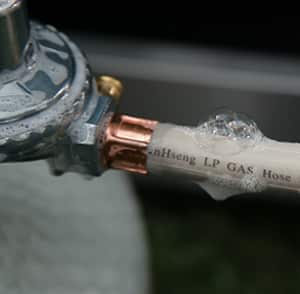 The soap can be put in a spray bottle or placed in a bowl for sponging on.
The soap can be put in a spray bottle or placed in a bowl for sponging on.
Dish washing soap is formulated to make lots of bubbles so it works better for the soap test for leaky gas.
Liquid laundry detergent doesn’t work as well as dish soap, as it is formulated to be low sudsing.
Remember to cover the entire hose assembly from the gas bottle valve to the hose attachment to the gas BBQ or gas heater with soap solution.
Open the valve to pressurise the system, without turning on the gas BBQ burners, and look for soap bubbles or sniff for the rotten egg smell.
This quick 60 second video shows how to perform the soap bubble test for leaky gas – soapy water leak test:
How to Do Soapy Water Leak Test – How to Detect Leaky Gas in Your Home
♦ To detect a gas leak in your home, start by putting some soapy water in a spray bottle or a dish.
♦ Turn on the LPG gas bottle without turning on the gas BBQ. This pressurises the system.
♦ Next, spray the gas BBQ, valve, regulator and hose assembly with the soapy water.
♦ Alternatively, you can apply the soapy water with a paint brush, basting brush or it can even be sponged on.
♦ Soap bubbles will form if there is leaky gas and you may also smell the gas.
♦ You need to test the entire assembly from the gas bottle valve all the way to where the gas hose attaches to the gas BBQ.
♦ When done, rinse with clean water to remove the soap solution.
♦ Remember to always soapy water leak test the lot every time you re-connect your gas bottle.
If you find leaky gas, turn off the gas bottle immediately!
Do not turn back on or attempt to use the gas BBQ until the problem is rectified.
How Do You Check for Gas Cylinder Leaks – Common Problem Areas
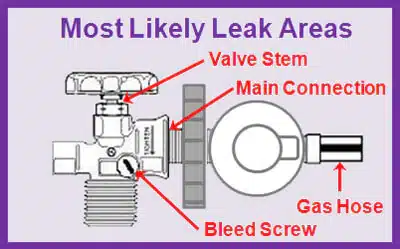
How Do You Check for BBQ Gas Bottle Leaks
To check for BBQ gas bottle leaks perform the soapy water leak test around the valve and connections.
You use the same test to detect a gas leak in your home and how you check for gas bottle leaks.
Poor connection to the gas bottle is the most frequent cause for leaky gas.
In many cases, the main connection is just not sufficiently tightened.
Dirt or damage to the connectors are also common causes of leaky gas.
Main Connection
The standard BBQ gas regulator in Australia is a LCC27 or POL gas regulator.
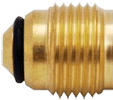 The male connector of the gas regulator, which screws into or onto the gas valve on your BBQ gas bottle, may have a rubber O-ring seal or it may rely on a metal to metal contact seal.
The male connector of the gas regulator, which screws into or onto the gas valve on your BBQ gas bottle, may have a rubber O-ring seal or it may rely on a metal to metal contact seal.
You should always inspect the regulator for damage, paying special attention to the connector, which screws into the BBQ gas bottle.
If it has a rubber O-ring, it also needs to be undamaged.
The connector and the female valve opening should both be clean and undamaged.
Pieces of dirt, nicks and scratches can prevent the two components from sealing, resulting in leaky gas.
Gas Hose
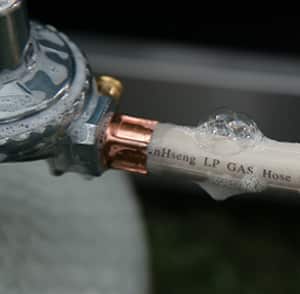 The gas hose is attached to the regulator on one end and the gas BBQ on the other end.
The gas hose is attached to the regulator on one end and the gas BBQ on the other end.
It can become damaged or deteriorate with age, causing leaky gas.
Dogs and other animals can also cause damage by chewing on the dangling hose.
Visually inspect the gas hose for cracking, splitting or other damage.
You should replace the gas hose if it shows any signs of damage or degradation.
It is good practice to replace the entire BBQ regulator and hose assembly, if it is old enough for the hose to have deteriorated, as regulators also wear with age.
Valve Stem
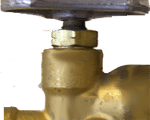 In Australia, BBQ gas bottles must be tested every ten years.
In Australia, BBQ gas bottles must be tested every ten years.
The gas valve is changed upon inspection and the valves are expected to last for the full ten years.
However, occasionally the valve will fail prematurely and start leaking from around the valve stem.
This is rare but it can happen.
Please see Gas Bottle-Cylinder Testing Facts for more information on the ten year testing process.
Bleed Screw
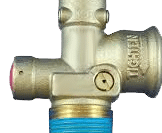 The bleed screw is a small slotted screw on the side of the BBQ gas bottle valve that lets gas vapour bleed off during the decanting refill process.
The bleed screw is a small slotted screw on the side of the BBQ gas bottle valve that lets gas vapour bleed off during the decanting refill process.
The refill technician opens it during the filling process and closes it, when done.
The screw can develop a slow gas leak if it becomes loose.
When to Test
The BBQ gas bottle, regulator & hose assembly should be checked using the soapy water leak test every time you reconnect your regulator to the BBQ gas bottle to the gas BBQ.
You should also use the soapy water leak test after any long period of non-use, such as at the beginning of gas BBQ season.
Soapy Water Solution For Soapy Water Gas Leak Test
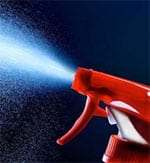 You will need a soapy water solution to do the soapy water gas leak test.
You will need a soapy water solution to do the soapy water gas leak test.
Mixing liquid hand soap with water should work fine.
Place the solution in a liquid spray bottle.
It’s a good idea to leave the spray bottle with the BBQ, so it’s always a handy reminder to perform the soapy water leak test.
No Ammonia
Your BBQ valve and fittings are made from brass.
You must never use any soapy water leak test solution that contains ammonia, when you do your testing for leaky gas.
Ammonia can cause brass to become brittle and crack.
Be aware that ammonia is found in many pre-prepared glass and surface cleaners, so make sure you read the label before use.
Extra Safety Tip
 The best practice gas safety advice is that BBQ gas bottles should only be in a vehicle for the minimum required transport time.
The best practice gas safety advice is that BBQ gas bottles should only be in a vehicle for the minimum required transport time.
When you do transport a BBQ gas bottle, you should consider one added precaution.
After making sure that the valve is firmly closed, you should soapy water leak test the entire valve assembly to check for any possible gas leaks, prior to transport.
DO NOT leave BBQ gas bottles in enclose vehicle unnecessarily.
New Residential LPG customer?
New Business LPG customer?
Existing ELGAS customer?
- Elgas to the Rescue with Helicopter LPG Delivery - November 14, 2024
- Outdoor Heaters: Outdoor Gas Heaters – Gas Patio Heater Guide - September 22, 2024
- LPG Meaning – LPG Means: What Does LPG Stand For - August 31, 2024
Steve Reynolds
Technical Consultant
Steve Reynolds is a leading expert in the LPG industry with over 22 years of experience. As part of the national management team at ELGAS, Steve ensures the safe and efficient storage, handling, and transportation of LPG. He serves as the lead investigator for incidents and collaborates with authorities on industry developments.
Steve is a technical advisor to Standards Australia and Gas Energy Australia (GEA), and an active member of the World LPG Association (WLPGA), contributing to global standards and technical reviews. He holds a BSc. (Hons) in Industrial Chemistry from UNSW and has held senior safety and technical roles at ELGAS, making him a trusted authority in LPG safety and standards.